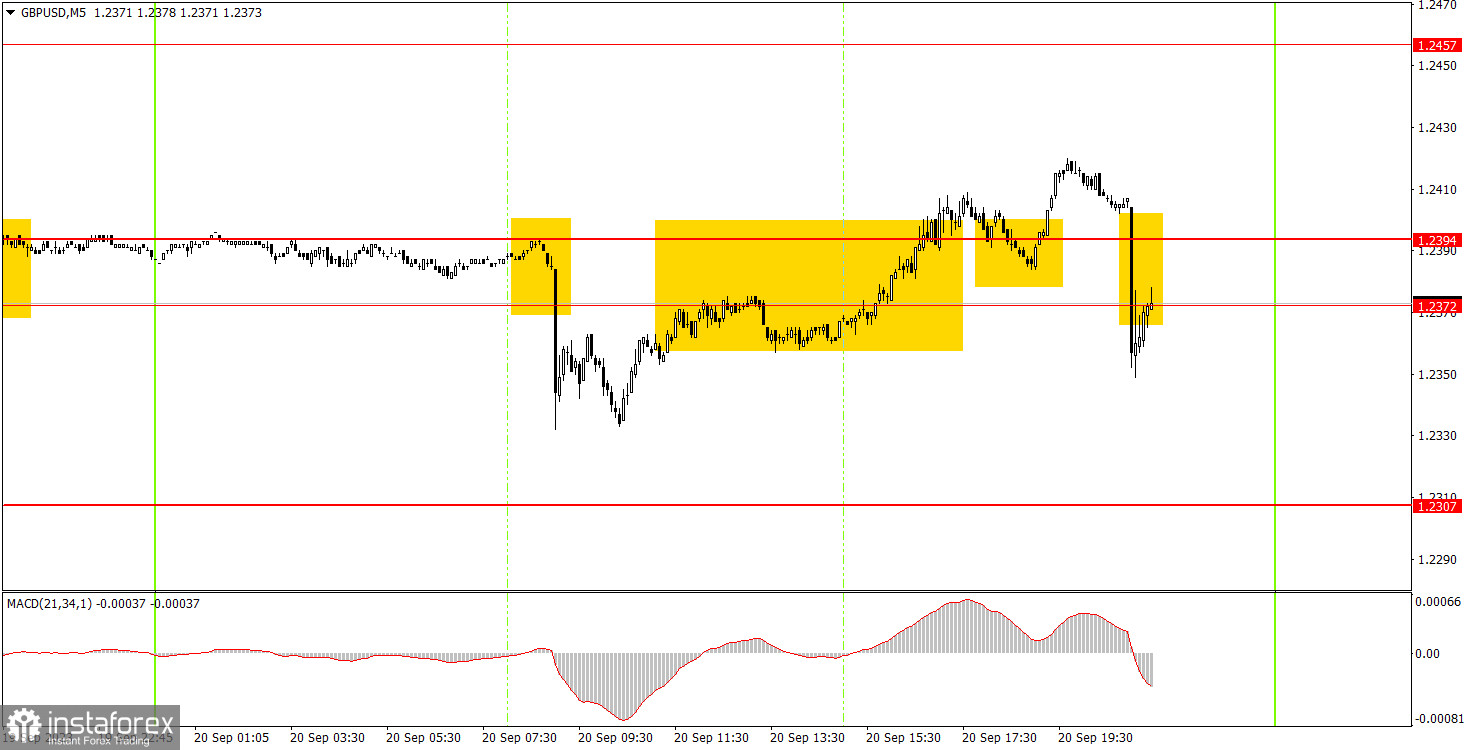Analyzing Wednesday's trades:
GBP/USD on 30M chart

At the end of Wednesday, GBP/USD erased the bounce it experienced earlier in the day, so now the pair remains under some selling pressure once again. The movements were quite erratic, but the fundamental backdrop was strong and diverse. Wednesday morning brought the release of UK CPI numbers and both core and headline CPI came in below expectation, which, in theory, should have put pressure on the British pound, as it diminishes the likelihood of the Bank of England maintaining a hawkish stance. The pound did fall, but it quickly recovered.
In the evening, the pound dropped after the FOMC meeting, even though the interest rate remained unchanged, and there were no significant reasons for the US dollar to rise. However, in both cases, there was a "surge of emotions" in the market. These are short periods when the market doesn't move in the most logical way due to a strong fundamental background. We can expect an equally strong backdrop on Thursday, so the final assessment should be made then.
GBP/USD on 5M chart

On the 5-minute chart, the pair saw a good number of trading signals, but let's examine them in more detail. First, a sell signal was formed around the 1.2372-1.2394 range, but it formed precisely during the UK inflation reports, and the decline didn't last long. The next buy signal was formed during the middle of the US session, and it wasn't a reasonable decision to enter the market just before the FOMC meeting. Alternatively, one should have left an hour before the results were announced. In any case, it was difficult to make a profit.
Trading tips on Thursday:
On the 30-minute chart, GBP/USD continues to move predominantly sideways. Despite the increased volatility, the nature of the movement remains unchanged. On the other hand, we can expect an equally strong fundamental backdrop on Thursday, which means that we should just endure the day, and draw conclusions on Friday. The key levels on the 5M chart are 1.2245, 1.2307, 1.2372-1.2394, 1.2457-1.2488, 1.2544, 1.2605-1.2620, 1.2653, 1.2688, 1.2748, 1.2787-1.2791. Once the price moves 20 pips in the right direction after opening a trade, you can set the stop-loss at breakeven. On Thursday, the Bank of England will announce its rate decision, which is very important and can trigger a market reaction no less significant than the FOMC meeting. The US will release two secondary reports, which will be overshadowed by the central banks' meetings.
Basic trading rules:
1) The strength of the signal depends on the time period during which the signal was formed (a rebound or a break). The shorter this period, the stronger the signal.
2) If two or more trades were opened at some level following false signals, i.e. those signals that did not lead the price to Take Profit level or the nearest target levels, then any consequent signals near this level should be ignored.
3) During the flat trend, any currency pair may form a lot of false signals or do not produce any signals at all. In any case, the flat trend is not the best condition for trading.
4) Trades are opened in the time period between the beginning of the European session and until the middle of the American one when all deals should be closed manually.
5) We can pay attention to the MACD signals in the 30M time frame only if there is good volatility and a definite trend confirmed by a trend line or a trend channel.
6) If two key levels are too close to each other (about 5-15 pips), then this is a support or resistance area.
How to read charts:
Support and Resistance price levels can serve as targets when buying or selling. You can place Take Profit levels near them.
Red lines are channels or trend lines that display the current trend and show which direction is better to trade.
MACD indicator (14,22,3) is a histogram and a signal line showing when it is better to enter the market when they cross. This indicator is better to be used in combination with trend channels or trend lines.
Important speeches and reports that are always reflected in the economic calendars can greatly influence the movement of a currency pair. Therefore, during such events, it is recommended to trade as carefully as possible or exit the market in order to avoid a sharp price reversal against the previous movement.
Beginners should remember that every trade cannot be profitable. The development of a reliable strategy and money management are the key to success in trading over a long period of time.





















